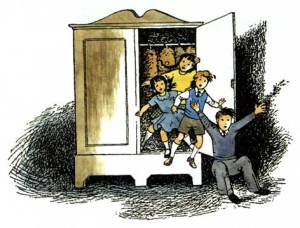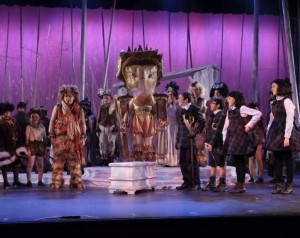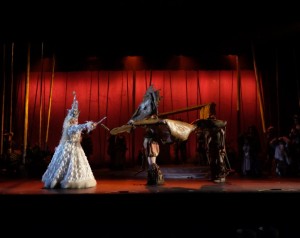Themes are defined as the main ide as present throughout a given work. They are the important messages that we take away when reading or watching a play. As the students open the doors to this seemingly normal wardrobe and find themselves in the whimsical fantasy land of Narnia, there will be a lot of new ideas presented to them. It will be helpful for the students to be able to identify important themes that are highlighted throughout the play to better understand it as a whole. In the play, The Lion, the Witch, and the Wardrobe, some of the most prevalent themes include bravery, friendship, hope, gluttony, and good versus evil. There is a great advantage in students understanding the importance of themes because once students can identify a theme, they can then better immerse themselves in the reading material. Themes provide connections for students. They allow for students to have different ways to relate to what is being read and to then see how these themes like bravery and friendship are continuously present everywhere. This is then helpful in comparing the story presented in this play to other works of literature because there is a greater knowledge of themes that the students will be able to apply.
as present throughout a given work. They are the important messages that we take away when reading or watching a play. As the students open the doors to this seemingly normal wardrobe and find themselves in the whimsical fantasy land of Narnia, there will be a lot of new ideas presented to them. It will be helpful for the students to be able to identify important themes that are highlighted throughout the play to better understand it as a whole. In the play, The Lion, the Witch, and the Wardrobe, some of the most prevalent themes include bravery, friendship, hope, gluttony, and good versus evil. There is a great advantage in students understanding the importance of themes because once students can identify a theme, they can then better immerse themselves in the reading material. Themes provide connections for students. They allow for students to have different ways to relate to what is being read and to then see how these themes like bravery and friendship are continuously present everywhere. This is then helpful in comparing the story presented in this play to other works of literature because there is a greater knowledge of themes that the students will be able to apply.
Bravery is being afraid and yet still being courageous and facing that fear. When moving towards the unknown, there is often a lot of uncertainty with what the outcome may be but taking that chance is what makes someone brave. It is stepping into something or somewhere completely out of one’s element, like Narnia for example, and continuously taking more and more steps forward. Aslan shows his bravery when he makes the deal with the White Witch that in exchange for Edmund’s freedom, he will give his own life. Aslan embodies a noble character and his actions highlight this fact. There was no way to tell what exactly might have happened after Aslan negotiated with the White Witch, but he was brave in stepping forward in order to save Edmund’s life. The theme of bravery is important in the play because it adds an important dimension of heroism to Aslan’s character as well as all of the friends of Narnia who risk their lives in order to defeat the White Witch for the greater good. Without that bravery, the same results might not have occurred and it may have been winter forever.
Describe a scene in the play that portrayed a moment of bravery. Why do you think it might be good to be brave? When have you been brave in your own life?
 Friendship is an important aspect of the story because it begins the connection that the children have with the characters of Narnia. When Lucy first arrives in Narnia, she instantly befriends Mr. Tumnus and because of this Mr. Tumnus does not turn Lucy in to the White Witch. In return, Lucy goes back to Narnia to find Mr. Tumnus and tries to find out what happened to him when she learns he has been taken away. The children make friends with important characters in the play like Mr. and Mrs. Beaver that help them through their journey in finding Aslan and eventually defeating the White Witch. Amazing things can happen with the help of good friends.
Friendship is an important aspect of the story because it begins the connection that the children have with the characters of Narnia. When Lucy first arrives in Narnia, she instantly befriends Mr. Tumnus and because of this Mr. Tumnus does not turn Lucy in to the White Witch. In return, Lucy goes back to Narnia to find Mr. Tumnus and tries to find out what happened to him when she learns he has been taken away. The children make friends with important characters in the play like Mr. and Mrs. Beaver that help them through their journey in finding Aslan and eventually defeating the White Witch. Amazing things can happen with the help of good friends.
Who are friends in the play? What does friendship mean to you?
Hope: Before Lucy, Edmund, Susan, and Peter arrived in Narnia, the concept of hope was something that did not really exist amongst the inhabitants of this magical land. The White Witch kept the world in eternal winter without the arrival of Christmas Day. Characters like Mr. Tumnus and Mr. and Mrs. Beaver lived without hope that there would ever be warmth and that the tyranny of the White Witch would never end. When the children arrived through the wardrobe, the prophecy was remembered and a chance at defeating the White Witch became a possibility. The friends of Narnia had hope that they would one day see Christmas and a happier land. The play shows how hope is a powerful feeling because when the members of Narnia united in their hope for change, Christmas Day arrived and the White Witch’s power over Narnia was weakening.
Gluttony: (exces sive eating and drinking) as seen with Edmund when he is first put under the White Witch’s spell and given his first Turkish Delight. His greed and desire for Turkish Delight gets Edmund into a lot of trouble in the play because he is willing to do anything for more of this food even if that means giving up his brother and sisters to the White Witch. The play highlights the negative consequences of having gluttony when Edmund is betrayed and taken away by the White Witch.
sive eating and drinking) as seen with Edmund when he is first put under the White Witch’s spell and given his first Turkish Delight. His greed and desire for Turkish Delight gets Edmund into a lot of trouble in the play because he is willing to do anything for more of this food even if that means giving up his brother and sisters to the White Witch. The play highlights the negative consequences of having gluttony when Edmund is betrayed and taken away by the White Witch.
Good vs. Evil: In the play there is a clear portrayal of good characters and evil characters. The theme of good versus evil is a classic motif in literature. In The Lion, the Witch and the Wardrobe, there are clear distinctions between which characters are good and which characters are evil. The children are kind and friendly to the animals of Narnia while the White Witch is controlling and wicked in her demeanor and actions. While watching the play, it is clear from the tone of voice of the characters, their stature when walking, and in their relationship to the evil White Witch.
between which characters are good and which characters are evil. The children are kind and friendly to the animals of Narnia while the White Witch is controlling and wicked in her demeanor and actions. While watching the play, it is clear from the tone of voice of the characters, their stature when walking, and in their relationship to the evil White Witch.
What makes a good character? What makes an evil character? Where would you say Edmund fits into these descriptions?
Written by: Sam Pfau
Determine a theme or central idea of a text and how it is conveyed through particular details; provide a summary of the text distinct from personal opinions or judgments.
Analyze how a particular sentence, chapter, scene, or stanza fits into the overall structure of a text and contributes to the development of the theme, setting, or plot.